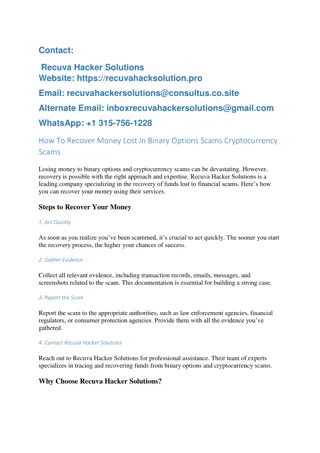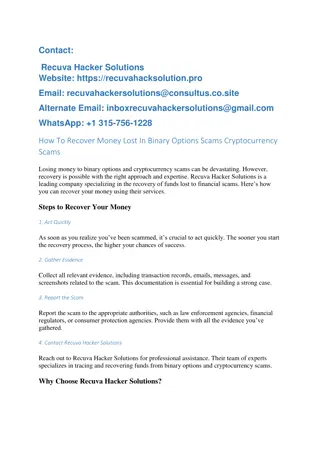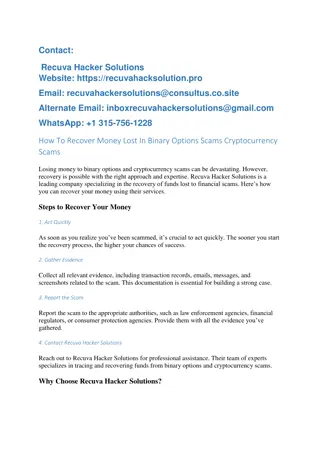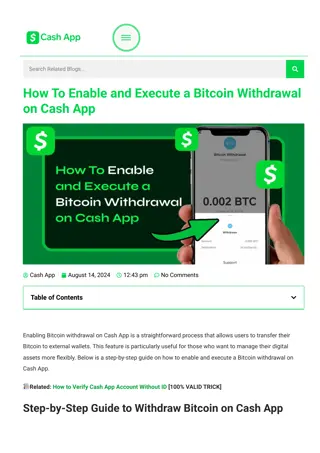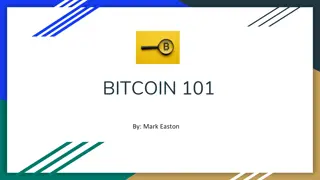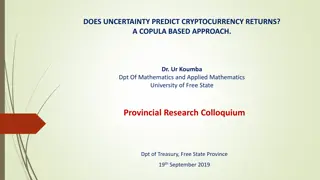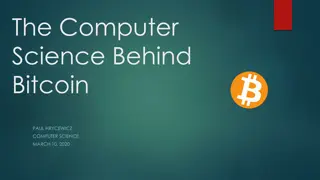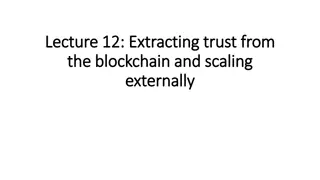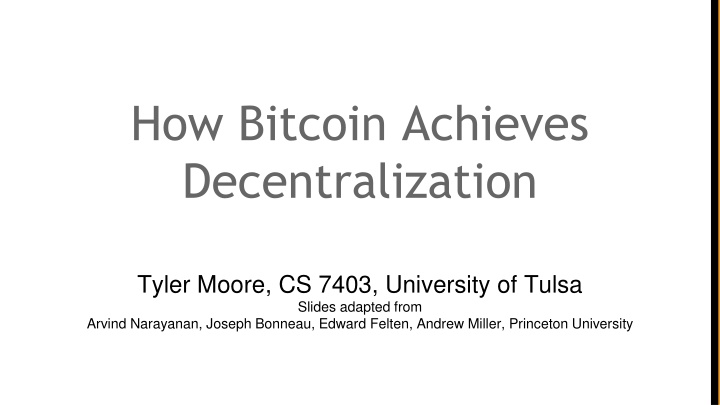
How Bitcoin Achieves Decentralization
Explore the mechanisms through which Bitcoin achieves decentralization, including distributed consensus, incentives, and the role of proof-of-work. Learn about the key aspects of decentralization in Bitcoin, such as ledger maintenance, transaction validation, and the creation of new bitcoins.
Download Presentation

Please find below an Image/Link to download the presentation.
The content on the website is provided AS IS for your information and personal use only. It may not be sold, licensed, or shared on other websites without obtaining consent from the author. If you encounter any issues during the download, it is possible that the publisher has removed the file from their server.
You are allowed to download the files provided on this website for personal or commercial use, subject to the condition that they are used lawfully. All files are the property of their respective owners.
The content on the website is provided AS IS for your information and personal use only. It may not be sold, licensed, or shared on other websites without obtaining consent from the author.
E N D
Presentation Transcript
How Bitcoin Achieves Decentralization Tyler Moore, CS 7403, University of Tulsa Slides adapted from Arvind Narayanan, Joseph Bonneau, Edward Felten, Andrew Miller, Princeton University
Overview Centralization vs. decentralization Distributed consensus Consensus without identity: the block chain Incentives and proof-of-work Putting it all together 2
Overview Centralization vs. decentralization Distributed consensus Consensus without identity: the block chain Incentives and proof-of-work Putting it all together 3
Centralization vs. decentralization Competing paradigms that underlie many digital technologies
Decentralization is not all-or-nothing E-mail: decentralized protocol, but dominated by centralized webmail services
Aspects of decentralization in Bitcoin 1. Who maintains the ledger? 2. Who has authority over which transactions are valid? 3. Who creates new bitcoins? 4. Who determines how the rules of the system change? 5. How do bitcoins acquire exchange value? Beyond the protocol: exchanges, wallet software, service providers...
Aspects of decentralization in Bitcoin Peer-to-peer network: open to anyone, low barrier to entry Mining: open to anyone, but inevitable concentration of power often seen as undesirable Updates to software: core developers trusted by community, have great power
Overview Centralization vs. decentralization Distributed consensus Consensus without identity: the block chain Incentives and proof-of-work Putting it all together 8
Bitcoins key challenge Key technical challenge of decentralized e-cash: distributed consensus or: how to decentralize ScroogeCoin
Defining distributed consensus The protocol terminates and all correct nodes decide on the same value This value must have been proposed by some correct node
Bitcoin is a peer-to-peer system When Alice wants to pay Bob: she broadcasts the transaction to all Bitcoin nodes signed by Alice Pay to pkBob: H( ) Note: Bob s computer is not in the picture
How consensus could work in Bitcoin At any given time: All nodes have a sequence of blocks of transactions they ve reached consensus on Each node has a set of outstanding transactions it s heard about
How consensus could work in Bitcoin Tx Tx Tx Tx Tx Tx Tx Tx Tx Tx Tx Tx Consensus protocol Tx Tx Tx Tx Tx Tx OK to select any valid block, even if proposed by only one node
Why consensus is hard Nodes may crash Nodes may be malicious Network is imperfect Not all pairs of nodes connected Faults in network Latency No notion of global time
Many impossibility results Byzantine generals problem Fischer-Lynch-Paterson (deterministic nodes): consensus impossible with a single faulty node
Understanding impossibility results These results say more about the model than about the problem The models were developed to study systems like distributed databases
Bitcoin consensus: theory & practice Bitcoin consensus works better in practice than in theory Theory is still catching up BUT theory is important, can help predict unforeseen attacks
Some things Bitcoin does differently Introduces incentives Possible because it s a currency! Embraces randomness Does away with the notion of a specific end-point Consensus happens over long time scales about 1 hour
Overview Centralization vs. decentralization Distributed consensus Consensus without identity: the block chain Incentives and proof-of-work Putting it all together 19
Why identity? Pragmatic: some protocols need node IDs Security: assume less than 50% malicious
Why dont Bitcoin nodes have identities? Identity is hard in a P2P system Sybil attack Pseudonymity is a goal of Bitcoin
Weaker assumption: select random node Analogy: lottery or raffle When tracking & verifying identities is hard, we give people tokens, tickets, etc. Now we can pick a random ID & select that node
Key idea: implicit consensus In each round, random node is picked This node proposes the next block in the chain Other nodes implicitly accept/reject this block by either extending it or ignoring it and extending chain from earlier block Every block contains hash of the block it extends
Consensus algorithm (simplified) 1. New transactions are broadcast to all nodes 2. Each node collects new transactions into a block 3. In each round a random node gets to broadcast its block 4. Other nodes accept the block only if all transactions in it are valid (unspent, valid signatures) 5. Nodes express their acceptance of the block by including its hash in the next block they create
What can a malicious node do? Double- spending attack signed by A CA B Pay to pkB: H( ) signed by A CA A Pay to pkA : H( ) Honest nodes will extend the longest valid branch
From Bob the merchants point of view 1 confirmation 3 confirmations CA B Double-spend probability decreases exponentially with # of confirmations double-spend attempt CA A Hear about CA B transaction 0 confirmations Most common heuristic: 6 confirmations
Recap Protection against invalid transactions is cryptographic, but enforced by consensus Protection against double-spending is purely by consensus You re never 100% sure a transaction is in consensus branch. Guarantee is probabilistic
Overview Centralization vs. decentralization Distributed consensus Consensus without identity: the block chain Incentives and proof-of-work Putting it all together 28
Assumption of honesty is problematic Can we give nodes incentives for behaving honestly? Can we reward nodes that created these blocks? Can we penalize the node that created this block? Everything so far is just a distributed consensus protocol But now we utilize the fact that the currency has value
Incentive 1: block reward Creator of block gets to include special coin-creation transaction in the block choose recipient address of this transaction Value is fixed: currently 25 BTC, halves every 4 years Block creator gets to collect the reward only if the block ends up on long-term consensus branch!
Theres a finite supply of bitcoins Total supply: 21 million Total bitcoins in circulation Block reward is how new bitcoins are created First inflection point: reward halved from 50BTC to 25BTC Runs out in 2040. No new bitcoins unless rules change Year
Incentive 2: transaction fees Creator of transaction can choose to make output value less than input value Remainder is a transaction fee and goes to block creator Purely voluntary, like a tip
Remaining problems 1. How to pick a random node? 1. How to avoid a free-for-all due to rewards? 1. How to prevent Sybil attacks?
Proof of work To approximate selecting a random node: select nodes in proportion to a resource that no one can monopolize (we hope) In proportion to computing power: proof-of-work In proportion to ownership: proof-of-stake
Equivalent views of proof of work 1. Select nodes in proportion to computing power 1. Let nodes compete for right to create block 1. Make it moderately hard to create new identities
Hash puzzles nonce prev_h Tx Tx To create block, find nonce s.t. H(nonce prev_hash tx tx) is very small Output space of hash Target space If hash function is secure: only way to succeed is to try enough nonces until you get lucky
PoW property 1: difficult to compute As of Aug 2014: about 1020hashes/block Only some nodes bother to compete miners
PoW property 2: parameterizable cost Nodes automatically re-calculate the target every two weeks Goal: average time between blocks = 10 minutes Prob (Alice wins next block) = fraction of global hash power she controls
Key security assumption Attacks infeasible if majority of miners weighted by hash power follow the protocol
Solving hash puzzles is probabilistic 10 minutes Probability density Time to next block (entire network)
PoW property 3: trivial to verify Nonce must be published as part of block Other miners simply verify that H(nonce prev_hash tx tx) < target
Mining economics If mining reward (block reward + Tx fees) hardware + electricity cost > Profit Complications: fixed vs. variable costs reward depends on global hash rate
Overview Centralization vs. decentralization Distributed consensus Consensus without identity: the block chain Incentives and proof-of-work Putting it all together 43
Recap Identities Block chain & consensus Transactions Hash puzzles & mining P2P network
Bitcoin has three types of consensus Value State Rules
Bitcoin is bootstrapped security of block chain health of mining ecosystem value of currency
What can a 51% attacker do? Steal coins from existing address? Suppress some transactions? From the block chain From the P2P network Change the block reward? Destroy confidence in Bitcoin?
Remaining questions How do we get from consensus to currency? What else can we do with consensus?

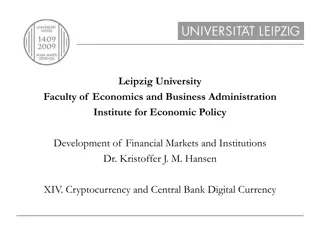

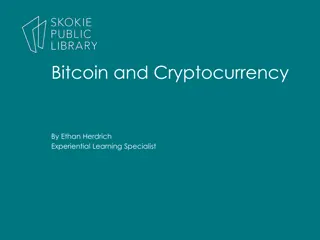
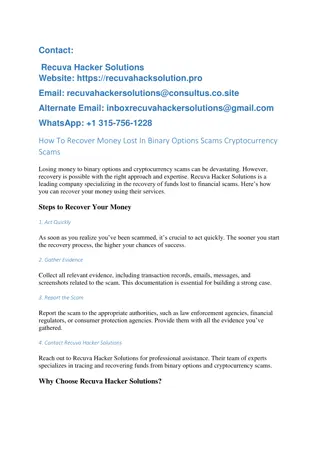

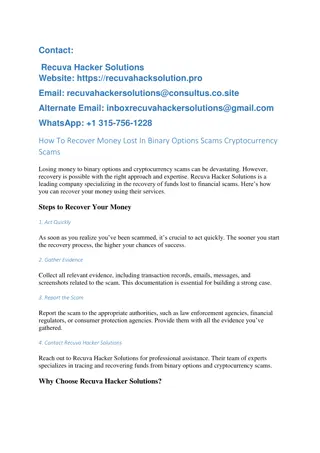

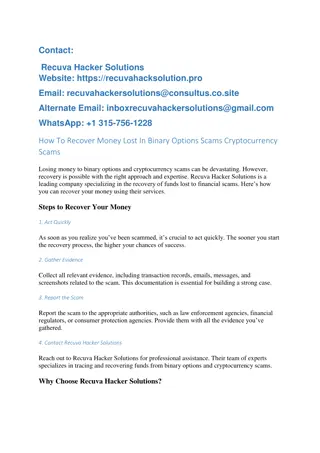
![101 Reviews How to Recover Lost Bitcoin [Scammed/Stolen Funds]](/thumb/153354/101-reviews-how-to-recover-lost-bitcoin-scammed-stolen-funds.jpg)
